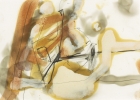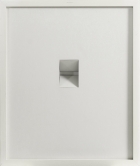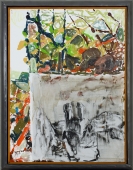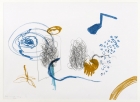
Artist | Mario Dalpra (*1960)
https://www.artist-info.com/artist/Mario-Dalpra
About the work
About the work
Dust. Sea. Storm. Volcano. Abroad. Isolation.
1 Sidney, 1997
He'd like to create an illusion yet he's got the green light signals often stop him he is isolated is pretty annoyed as an artist tries to adapt to the collective look but feels most at home in the distance he then notices what is wrong about beauty, for instance, that of a firebird (able to appear in the form of ladybird or woman) yet time and again still seeks the massive influence of a culture.
2 Ubud, 1997
The analysis of a woman, after she has disappeared, and also of a foreign culture, which exercises great power automatically leads to abstraction just as the volcano behind the house represents a complex event which keeps the process of making going in which he can appear like an Italian futurist investigating the myths of reality on the spot, without fearing to be viewed as a popular consumer, and everything can be fitted together in formations despite the difficulty of remembering the theatrical game that human beings play when they throw him back upon the eternal question of whether his life is really identical with himself.
3 Rio de Janeiro, 1998
At the beginning there is usually a difficult start, a challenge, a general or particular dissatisfaction. Every painting is a discovery, a revelation of the thoughts in one's head, a process which is always starting again from the beginning. This creates vibrations, emotional and intellectual ones, connecting and combining with one another. The artist cannot just follow some impulse or other and jump onto the canvas and rummage around there, but from the beginning has to find a balance between emotion and idea in a carefully considered way.
He creates two personalities, which mutually influence each other in reciprocal action - himself and the painting, which develops a character of its own, against which he has to struggle. At some point or other it has to be rejected. Which is why a Rejection of the Self takes place in the form of the work. It should not be able to pene-trate him again.
In this constant confrontation there arise doubts and uncertainties towards the painting, which is a repeated attempt to create a language with new aesthetics and dynamics, with something fundamentally new.
Every painting is a new element in a greater story, which arises in the course of time and insofar is part of the overall picture which represents one's life work.
Every painting has a life of its own, goes its own way, represents the artist at different places at the same time: it distributes the visual energies which refer to him as its creator and allow him to be present in material form for the beholder. It is a multi-present stimulator which makes possible the emotional vibrations, thoughts, ten-sions and even the creative process itself, all of which it accompanies and communicates to the beholder. The artist is the transmitter, the painting the medium, and the beholder the receiver.
The completion of a painting is The Triumph. Every finished painting is a brief triumph. It radiates, it illumina-tes, it is itself radiant and seeks to remain so. For the moment it does not wish to be surpassed.
Something non-existent has been given form and modulated until it becomes a statement. Modulation entails mingling the intellectual and the emotional on the surface, adapting to two-dimensionality, to the given format, which may represent limitations of whatever kind.
A white page with the title could also be helped by the artist to achieve a certain meaning. The title constitutes the literary component of a painting, by means of which thoughts and associations connected with the backgro-und and the extra-pictorial reality are provoked. The intention behind I Am Your Comics is that the beholder may continue to relate the story of the picture. He himself can create the pre-painting and the post-painting and can latch on to the artist's process. A white picture would therefore signalise: divide the surface into as many sections as you wish and create the whole story from it yourself.
The production of a painting also always involves Mechanical Power. This does not only refer to the necessary power of muscles and bones, but also to the preparation for certain courses of action which have to be repeated in order to give the painting a chance of emerging into the light at all. At some point or other the artist will move like a machine, with or without music, at any rate as a centre of potency and energy, in the midst of the noises of his work and body.
A first step is needed for every painting. Yet every painting can also be a First Step itself, the start of a large series. Pictorial production is an eternally ongoing process, from one painting to the next, from one series to ano-ther, linear and yet at the same time rising to peaks and plummeting to depths.
The Idea of Movement is present both previously and also during the work on a painting or a series. Even in a state of rest, before getting up every morning, after every night, in which some dark impulse for a painting has appeared in one's dreams. From here movement develops as something clarifying, explanatory and necessary.
The artist then directs the Focus of his entire Attention towards a certain area. In doing so, everything may be important and be incorporated into the painting: walking around, visiting museums, strolling back and forth, natural forms, human events, the impressions made by works of art. Perhaps every new work is preceded by a kind of trance, which then passes over into the complex process of finding form and colour. Ideas and move-ments have to be unified - that is the secret task, independent of the place of production.
Every picture should display Brilliant Contrasts. In doing so it is not important whether it is a contrast between white and black or between the primary colours or even between broken colours. It is purely a matter of the sharpness and the presence of the respective picture. Yet it is also a matter of the contradictions which derive from its places of origin.
For Dalpra these places are Australia, Indonesia and Brazil. Their influences are extremely contradictory. Every contradiction is important for him. He is not afraid of contrasts. They do not devour him, but change him in a positive way. He seeks and finds another conception of the world, does not remain obsessed with some apparent certainty, but becomes open and delights in the act of creating.
Bleeding into Another means that the intellectual vibrations intervene in the life of another person, triggering off feelings. Energy leaves the painting and enters the person facing it. Everyone feels for themselves, individually, yet under the influence of the painting. Blood is movement, life, vivacity and thus something very positive. It is the very elixir of life. Bleeding represent a mingling of two opposites and thus also the things which result from it. Furthermore, it is almost as if all the paintings at different places are connected by a network of veins. They form this network in which the blood of the artist flows, as it were. With his paintings he creates a net which spans the world, he breathes life into them with his blood, from which others can nourish themselves, if they know how to do so.
There is a Separation involved in every pictorial utterance. He separates himself above all from everything which has gone before, even from his own work, and that is a Clear Cut. Then the first step is taken towards something new, perhaps to a new Narrative Sequence.
Steps create an end and at the same time a new beginning, cutting off the past. They bring Dalpra above all to a new geographical background, which in turn may have a stimulating effect. He also likes to return to every place which he enjoyed being at. Every return brings an encore, something new. When in Rio again, he would study the surroundings, the movement of this country even more thoroughly, the dust, the sea, the storms etc., and all the effects which are more powerful, more impetuous, more intensive than in his home country. The people in the foreign country are not necessarily the main subject, yet they belong to the totality of the effect. Their sequences of movement, their dance creates something general, takes its place in the series of movements of the external world, characterises the respective culture. Australia is predominantly experienced by Dalpra as hectic and businesslike, Indonesia as religious, Brazil as having a relaxed presence.
The artist always obtains Final Clarity only in the final paitning, after he has already absorbed everything which offers itself to him, unified it within himself. It is the nearest one can get to a little perfection. He then feels himself Intensely Unified on the spot. In this way Vivid Pictorial Structures arise, as a result of the Vital Attractions which are specific to the locality.
After completing the painting or a series there is relaxation. The creative process represents a general purification which then allows the artist to perceive himself as a private person again. The Invasion of Privacy therefore entails that he once more allows himself privacy, but also that his pictures, as his ambassadors, as his representatives, conquer the world and hold the fort there. They occupy the privacy of others, the beholders, send signals to their private inner and outer spaces, have an effect on their personal imagination, make it possible for them to have an Expressive Feeling, which perhaps comes close to that of the artist. The trigger is at any rate a Handmade Object - it shows the results of unique manual activity, the outcome of all the intellectual processes during a certain phase.
A Pop Sequence stands out, rises up, has a life of its own, which is connected to stubbornness, which Dalpra associates with pop music. For him pop is motion, revolution, but also the colour of a cake with pink icing, although it could also be orange or pea-green. When he works with colours and oils they leave behind a Realistic Smell, which clings to the pictures for a long time.
Every painting indicates the uninterrupted search resulting from a Change of Place, an act of placing oneself at the mercy of the unfamiliar. The most wonderful journeys do not take place in the mind, but are undertaken out of curiosity to the outside world. After every arrival he very quickly creates for himself a small circle of the familiar, in order to be able then to react to the foreign environment with an Emotional Answer. He says to himself: I Can Get It, and goes about conquering this other place intellectually and emotionally. What is foreign stimulates and activates him. He gets what is new and goes about the business of pictorial realization.
Lipstick Cartridges do not have to be actually glimpsed in order to give a painting this title. All it takes is a memory, which a paitning triggers off while it is being named, for example the memory of a glimpse of lipstick cartridges which lay on the beach in Rio.
The Upswing has something to do with optimism and the continuation of work. However, a Curators' Fuck is not actually what it indicates, but rather places Dalpra in the (Austrian) art scene and the role which curators play in it, namely that of supra-artists, who, with their categorisation and arrogant search for the new, restrict and exclude the creators of art.
A curator does not achieve a Clothed Brushstroke, he does not dip a brush into a pot of paint, from which it then returns clothed, only in order to then unclothe during its application to paper or canvas. Solely the artist - he who actually directs the brush - is capable of unclothing it and grasping its ever new temporary nakedness as the animation to continue and complete a picture and thus to constantly recreate his self.
E. A. Richter
Solo Exhibitions
Solo Exhibitions
1985 Gallery EbendorferstraBe, Vienna, Austria
1986 Gallery Tangente, Liechtenstein
1987 Neue Gallery, Vienna, Austria
1987 Fattoria il Poggio, Rignano sull Arno, Italy
1989 Neue Gallery, Vienna, Austria
1989 Apostelhof Gallery, Vienna, Austria
1990 Irving Galleries, Sydney, Australia
1990 Glacis Gallery, Graz, Austria
1990 Apostelhof Gallery, Vienna, Austria
1991 Gallery Hamettner, Stoob, Burgenland, Austria
1991 Realities Gallery, Melbourne, Australia
1991 Gallery Hamettner, Stoob, Austria
1991 Glacis Gallery, Graz, Austria
1992 Manning Galleries, Adelaide, Australia
1992 Irving Galleries, Sydney, Australia
1992 Gallery, Tokyo, Japan
1993 Glacis Gallery, Graz, Austria
1993 Z-Art Gallery, Forchtenstein, Austria
1993 Apostelhof Gallery, Vienna, Austria
1993 Sherman Galleries, Sydney, Australia
1994 Loos Haus, Vienna, Austria
1994 Gallery Hamettner, Stoob, Austria
1994 Art Attack Alternative Space Gallery, Seattle, WA, USA
1995 Glacis Gallery, Graz, Austria
1995 Paul Greenaway Gallery, Adelaide, Australia
1995 Dialogue Gallery, Seattle, WA, USA
1996 Kfinstlerhaus Thum and Taxis, Bregenz, Austria
1996 Pimmingstorfer Gallery, Peuerbach, Austria
1996 Gallery Hamettner, Stoob, Burgenland, Austria
1996 Apostelhof Gallery, Vienna, Austria
1996 Philips Gallery, Vienna, Austria
1996 L5 Gallery, Seattle, USA
1996 Gallery 3, Klagenfurt, Austria
1997 Apostelhof Gallery, Primavera, Vienna, Austria
1997 Apostelhof Gallery, (sculptures from Indonesia) Vienna, Austria
1998 Paul Greenaway Art Gallery, Adelaide, Australia
1998 Fattoria il Poggio (sculptures from Indonesia), Italy
1998 Apostelhof Gallery, Vienna, Austria
1998 Paul Greenaway Art Gallery, Adelaide Autralia
1998 Fattoria il Poggio, (skulptures from Indonesia), Italy
1998 Apostelhof Gallery, Vienna, Austria
1998 Burch and Klemm Gallery, Berlin, Germany
Group Exhibitions
Group Exhibitions
1985 Palais Liechtenstein, Vorarlberg, Austria
1987 International Art Fair, Basel, Switzerland
1988 Gallery Eva Poll, Berlin, Germany
1989 International Festival of Art, Cahours, France
1989 Milbum and Art Gallery, Sydney, Australia
1990 Wolfgang Gurlitt Museum, Linz, Austria
1990 Australian Contemporary Art Fair 2, Melbourne, Australia
1990 Christopher Leonard Gallery, New York, USA
1991 Neue Gallery, Linz, Austria
1991 Realities Gallery, Melbourne, Australia
1992 Sherman Galleries, Sydney, Australia
1993 Neue Gallery, Linz, Austria
1993 Triennale of Contemporary Art, Hong Kong
1994 Thum and Taxis, Kiinstlerhaus, Bregenz, Austria
1994 Neue Gallery, Linz, Austria
1995 Thum and Taxis, Ktinstlerhaus, Bregenz, Austria
1995 SchloI3 Peuerbach , Austria
1996 Ri5merquelle exhibition, (touring exhibition), Austria
1996 Miniinstallation, "Do it yourself', Tate Gallery, (the art of books) London
1997 Apostelhof Gallery, Vienna, Austria
1997 Paul Greenaway Gallery, Adelaide, Australia
1998 Centro de Arte H61io Oiticica, Rio de Janeiro, Brasil
1998 Annandale Galleries, Australia
Performances
Performances
1991 Four concertos for two pianos and orchestra with Gerald Futscher, Vienna, Austria
1991 Music to eight large works with Gerald Futscher, Vienna, Austria
1991 Concerto to black and white installation with Gerald Futscher, Vienna, Austria
1993 Concerto for two pianos with Gerald Futscher, Vienna, Austria
1993 Concerto for two pianos with Gerald Futscher, Forchtenstein, Austria
1993 Concerto for two pianos and trumpet with Gerald Futscher and Brett Baker, Sydney, Australia
1994 The "Yellow Suit" with Ulrich Plieschnig , Museum of Contemporary Art, Sydney, Australia and Centre Georges Pompidou, Paris, France
1994 The "Yellow Suit" with Ulrich Plieschnig Tate Gallery, London, GB.
1994 The "Yellow Suit" with Ulrich Plieschnig, Palazzo Grassi, Venice, Italy
1994 Concerto for two pianos with Gerald Futscher, Vienna, Austria
1994 Experiment for two pianos with Gerald Futscher, Tokyo, Japan
1994 Concerto for two pianos with Gerald Futscher, Seattle, USA
1995 Performance with Ulrich Plieschnig ( Intergalactic Busriders) Gallery of Modem Art, Auckland, New Zealand
1995 Performance with Ulrich Plieschnig, Art Gallery of Tasmania, Hobart, Tasmania
1995 Performance USA, North - South, East - West, with Ulrich Plieschnig. New York - New Orleans - Dallas - Santa F6 - Phoenix - Los Angeles - Las Vegas - San Francisco - Seattle - Denver - Kansas City - Chicago - Boston
1996 Performance "Dienstreise" with Ulrich Plieschnig, Indonesia,, Australia, N.Y, L.A, Hong Kong
1997 Indonesia, Ubud, with Ulrich Plieschnig, Project with artists from Indonesia, and
1997 Videoinstallation "Lifebuoy" with Harald Weisz
1998 Performance with Ulrich Plieschnig. Textlicking of books by Antonio Torres, Jorge Amado, and Joao Ubaldo Ribeiro, Rio de Janeiro, Brasil
 offers / Requests offers / Requests  |
About this service |
|---|
 Exhibition Announcements Exhibition Announcements  |
About this service |
|---|
 Visualization |
Learn more about this service | ||
|---|---|---|---|

Interested in discovering more of this artist's networks?
3 easy steps: Register, buy a package for a visualization, select the artist.
See examples how visualization looks like for an artist, a curator, or an exhibition place: Gallery, museum, non-profit place, or collector.

Exhibition History

|
SUMMARY based on artist-info records. More details and Visualizing Art Networks on demand. Venue types: Gallery / Museum / Non-Profit / Collector |
||||||||||||
| Exhibitions in artist-info | 6 (S 5/ G 1) |
Shown Artists - 1 of 1 artists (no. of shows) - all shows - Top 100
|
||||||||||
| Exhibitions by type | 6: 4 / 0 / 2 / 0 | |||||||||||
| Venues by type | 5: 4 / 0 / 1 / 0 | |||||||||||
| Curators | 0 | |||||||||||
| artist-info records | Jul 1998 - Sep 2011 | |||||||||||
|
Countries - Top 3 of 3 Austria (3) Germany (1) Switzerland (1) |
Cities 4 - Top of 4 Berlin (2) Wolkersdorf (2) Stoob (1) Zürich (1) |
Venues (no. of shows )
Top 5 of 5
|
||||||||||
|
Curators (no. of shows)
Top 0 of 0 |
| Galerie Wild - Zürich | S | Jun 2011 - Sep 2011 | Zürich | (2) | +0 | |
| Forum Schloß Wolkersdorf | S | Nov 2009 - Dec 2009 | Wolkersdorf | (31) | +0 | |
| Galerie im Turm | S | Sep 2001 - Oct 2001 | Berlin (Friedrichshain) | (58) | +0 | |
| Forum Schloß Wolkersdorf | G | Nov 2000 - Dec 2000 | Wolkersdorf | (31) | +0 | |
| Galerie Hametner | S | Sep 2000 - Oct 2000 | Stoob | (2) | +0 | |
| Galerie Burch & Klemm | S | Jul 1998 - Sep 1998 | Berlin | (10) | +0 | |
| Keep reading |







































